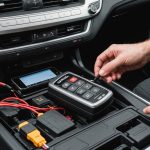Overview of Remote Start Systems
A remote start system allows vehicle owners to start their engines from a distance using a remote control or smartphone app. This innovation primarily enhances convenience and comfort, particularly during extreme weather conditions. Installed within the vehicle, these systems enable the engine to run for a predetermined time, warming or cooling the interior as needed.
Benefits of Remote Start Systems
For UK-made vehicles, remote start systems offer numerous advantages. One significant benefit is the ability to pre-condition the vehicle’s climate from the comfort of one’s home or workplace. This is particularly appealing during freezing winters or scorching summers, ensuring the vehicle is at an optimal temperature upon entry. Additionally, these systems enhance security by allowing users to start the car without unlocking the doors.
Also to read : Discover Sustainable Tire Choices for Electric Vehicles in the UK: Eco-Friendly Options Unveiled!
Installation Considerations
When considering installation, it is crucial to acknowledge potential compatibility issues with UK vehicle specifics. Many older models may require additional hardware to interface with the remote start system. Furthermore, professional installation is often recommended to ensure compatibility and maintain vehicle warranty. This precaution can circumvent potential technical issues or electrical mishaps. With correct installation, drivers can fully enjoy the system’s convenience without compromising vehicle integrity.
Tools and Materials Needed
When embarking on the installation journey of a remote start kit, having the right installation tools is essential. Key tools typically include wire strippers, crimpers, screwdrivers, and a multimeter. Each tool plays a crucial role in ensuring a smooth and efficient installation process, helping you manage the wiring and secure the equipment correctly.
Also to see : Exploring the Benefits of Multi-Zone Climate Control in UK Family Vehicles: Why It’s a Game Changer
Choosing the right remote start kit is equally important, especially for UK vehicles. Look for kits that are specifically designed to be compatible with your vehicle model and accommodate the unique regulation and wiring systems in the UK. Some recommended options include Viper’s comprehensive kits and Compustar’s user-friendly systems.
An often overlooked, yet crucial aspect of installation, is using safety equipment. This includes eye protection, gloves, and insulated tools to safeguard against electric shocks and other mishaps. Safety gear is not just a prerequisite but an assurance of personal safety during the complex process of adapting the vehicle’s wiring system.
Incorporating these tools, selecting the right kit, and prioritising safety equipment not only ensures a successful installation but also enhances your confidence and experience with your remote start system.
Preparation Before Installation
Before installing a remote start system, it is essential to follow a precise pre-installation checklist. Begin by ensuring your vehicle’s battery is fully charged, as this is critical for a successful installation. Verify the vehicle’s make and model to confirm its vehicle compatibility with the chosen remote start system. Some systems may not be suitable for all vehicles due to wiring, transmission, or engine type.
Next, review the legal requirements for remote start systems in the UK. Regulated under the Road Traffic Act, these systems must adhere to specific guidelines. Remote start systems should not allow the vehicle to remain idling unattended, meaning it should shut off if the door is opened without the key present.
When verifying vehicle compatibility, consult the manufacturer’s instructions and check for any necessary additional components or bypass modules. These modules ensure the remote start system communicates effectively with your vehicle’s electronic systems, preventing potential malfunctions.
Lastly, examine local regulations for any additional rules specific to your area. Adhering to these steps ensures a smooth installation process, maintaining compliance and functionality of your remote start system. These preliminary actions are crucial in safeguarding your investment and ensuring legal and operational efficiency.
Step-by-Step Installation Process
Installing a remote start system is a task that requires careful attention to detail and adherence to safety protocols. Understanding the installation steps is key to a successful setup.
Step 1: Disconnecting the Battery
Before any installation work begins, it’s crucial to safely disconnect the vehicle’s battery. This step helps prevent electrical surges and ensures your safety. Always begin by turning off the ignition and then carefully remove the negative terminal first, followed by the positive terminal. This sequence is important to avoid short circuits and ensure the system is unpowered during the installation.
Step 2: Accessing the Vehicle’s Wiring
Next, locate the areas where the vehicle’s wiring is accessible. Consult the wiring diagram for your specific vehicle model to identify critical points such as the ignition switch, brake, and tachometer wires. These wires are vital for the system’s seamless operation and are typically found under the dashboard. Gently remove panels if necessary, but ensure you have all necessary tools to avoid damaging the interior trim.
Step 3: Connecting the Remote Start Module
The final step involves the remote start configuration. Using the provided wiring diagram, connect the remote start module to the identified wires. Ensure each connection is secure and insulated to prevent any electrical faults. Double-check the connections as per the diagram to confirm each wire is in the correct location before proceeding to the next stage.
Post-Installation Configuration
Once installation is complete, it’s crucial to undertake system configuration to ensure all settings are optimal. Begin by adjusting the system for your specific vehicle’s needs, such as setting desired temperature and duration the car should run using the remote start function. Unified configuration typically enhances performance and reliability of the system.
Testing the remote start feature is essential for verification of system configuration. Follow these steps for a thorough inspection:
- Ensure your vehicle is in parked mode, with windows rolled up.
- Activate the remote start function following the manufacturer’s guidelines.
- Observe vehicle response, ensuring it starts remotely and all controls function as anticipated.
In case you encounter challenges, focus on these troubleshooting tips:
- Check: Review all connections, ensuring none are loose or incorrect.
- Reset: Sometimes resetting the system can solve unforeseen issues.
- Firmware Update: Make sure your system’s firmware is up to date for compatibility and enhanced performance.
Expert attention to these procedures will not only maximize your remote start system’s efficiency but also enhance your vehicle’s overall convenience and security.
Maintenance and Troubleshooting
Maintaining your remote start system is essential for its optimal performance. Regular checks can save time and prevent unforeseen issues. Start by inspecting the battery of your remote control and replacing it as needed. Ensure all connections are secure and look for any corrosion or wear. Keeping the antennas clean and free of obstructions can also enhance the signal strength.
When it comes to common issues encountered by users, a frequent problem is the car not starting remotely. This could be due to various reasons such as weak battery power, an inactive valet mode, or interference from other electronic devices. Check the vehicle’s battery first, as it may simply need charging or replacement. If valet mode is on, refer to your user manual to deactivate it. Should you encounter signal interference, try repositioning to a location with fewer electronic devices.
For further assistance, numerous resources for technical support are available. Many manufacturers offer online guides and forums, providing solutions and guidance. If problems persist, contact the manufacturer’s helpline for professional support, ensuring your remote start system remains reliable and efficient.
Conclusion and Additional Resources
For those keen on enhancing their knowledge of remote start systems, various resources are accessible to assist you further. Diving into installation videos can provide practical guidance that complements written instructions, offering a visually engaging method to understand the intricacies of setup processes. These videos can demystify confusing steps through demonstrations and tips from experts.
Furthermore, user manuals serve as indispensable tools for detailed information concerning specific models. They usually cover comprehensive explanations of functionalities, troubleshooting tips, and potentially unique features. Consulting these manuals will ensure the effective utilisation of remote start systems and might assist in resolving common issues encountered during installation or afterward.
- Remote Start Resources: Research available written and video guides to streamline your installation experience.
- Installation Videos: Utilize these visual aids for clarity on complex steps or to verify your procedure aligns with recommended techniques.
- User Manuals: Referring to manuals specific to your device will enhance understanding, ensuring optimal usage of all inherent features.
By leveraging these resources, users can embark on a more informed and confident journey towards mastering their remote start systems.











